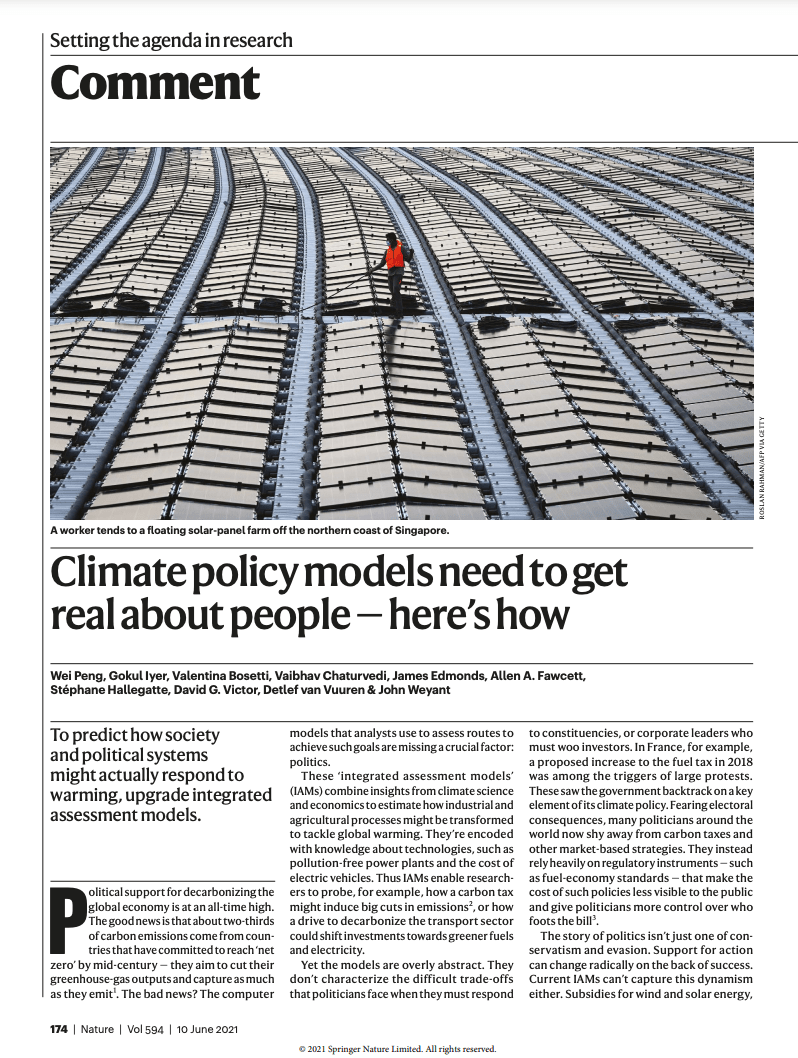Other Publications
Climate Policy Models Need to Get Real About People — Here’s How
Wei Peng, Gokul Iyer, Valentina Bosetti, Vaibhav Chaturvedi, James Edmonds, Allen A. Fawcett, Stéphane Hallegatte, David G. Victor, Detlef van Vuuren, John Weyant
June 2021 |
Suggested citation: Peng, Wei, Gokul Iyer, Valentina Bosetti, Vaibhav Chaturvedi, James Edmonds, Allen Fawcett, Stéphane Hallegatte et al. 2021. “Climate policy models need to get real about people — here’s how.” Nature, 594: 174-176. https://doi.org/10.1038/d41586-021-01500-2
Overview
This comment in Nature argues that the integrated assessment models (IAMs) used in climate research and policymaking could be improved to consider important questions of political economy. It lists eight insights that researchers could work into IAMs to make them more valuable to political decision-makers. These range from the effects of carbon lock-in on emissions trajectories to the impacts of government competence and public opinion on climate policymaking. The authors use these insights to identify 11 IAM "reforms", including model code changes, new factors and weights in functions, and novel datasets. Finally, they evaluate each reform's usefulness and ease of modelling from the perspective of three kinds of end-users: analysts studying emissions trajectories, national or subnational policymakers, and international policymakers.
Key Highlights
- Integrated assessment models (IAMs) are computational tools that combine our knowledge of climate science and economics to help us project and analyse pathways for climate change mitigation. Unfortunately, in their current form, they do not adequately reflect social and political realities.
- Eight insights that could help make IAMs more realistic and valuable to political decision-makers. These include the influence of interest groups, public opinion, and government competence on policy making; the effects of carbon lock-in and stranding of fossil-based energy assets on emissions trajectories; and the effects of trade and investment policies on the costs and political acceptability of new green technologies.
- 11 IAM ‘reforms’ capable of reflecting political economy insights include model code changes, new factors and weights in functions, novel datasets, and computation at different geographical and temporal resolutions.
- For each category of end-user, the reforms were evaluated for usefulness and ease of modelling, helping to zero in on high-priority areas for IAM improvement. For example, modelling the age structure of stranded assets is both easy to accomplish and highly useful in the context of national or subnational policy design.
Key Recommendations
- Incorporate political economy insights in IAM models to make them more realistic and relevant to real-world decision-making.
- Consult stakeholders before developing IAM reforms to make sure they actually help decision-makers.
- Engage political scientists and politically minded economists in IAM development.
Upgrade integrated assessment models (IAMs) to ensure they do a better job of accounting for social and political realities and informing real-world investment and policy choices.





